The ultimate NC500 itinerary
What is the NC500 route?
The NC500 – or, to give its full title, the North Coast 500 – could well be the UK’s ultimate scenic driving, cycling and walking route. Clocking in at 516 miles in length, this photogenic odyssey around the north coast of Scotland really is a fabulous bucket-list holiday experience – as long as you have planned well and have a manageable itinerary.
If you want to see the best attractions in the Highlands, a glamping or camping trip along the NC500 is the way to do it. The NC500 is one of the Pitchup team’s favourite UK road trips, and it seems many people agree with us, as it’s been voted one of the premier driving routes in the world. So we've put together this article to help you start planning your Scottish adventure today.
Below we’ve gathered together some of the best glamping and camping sites along the route –and with the economic climate being what it is at the moment, it's good to know that it's easy to do it all on a budget with pitch prices starting as low as £9 a night for two people.
Can you camp anywhere on the NC500?
Can you do the NC500 and camp all year round?
Where does the NC500 start?
The North Coast 500 officially starts and ends at Inverness Castle in Inverness city, the ‘capital of the Highlands’, and sweeps in a circle around the Highland region, taking in lush lochs, craggy coastline and lofty Highland peaks as it passes traditional whisky distilleries and must-visit towns and villages like Ullapool, Torridon, Durness and Dornoch.
NC500 camping
The scale of the NC500 makes camping or glamping a fantastic option for cheap, informal accommodation in the outdoors – all the better to appreciate the spectacular Highland countryside.
Seven-day NC500 route planner
The seven-day itinerary outlined below is meant as a guide only; you can easily shorten or lengthen your trip to suit your schedule, although taking at least five days is recommended. You don’t even need to start your adventure in Inverness; wherever you do decide to join the route, brown road signs labelled ‘NC500’ will help keep you on the right track, along with the NC500 app, GPS or satnav.
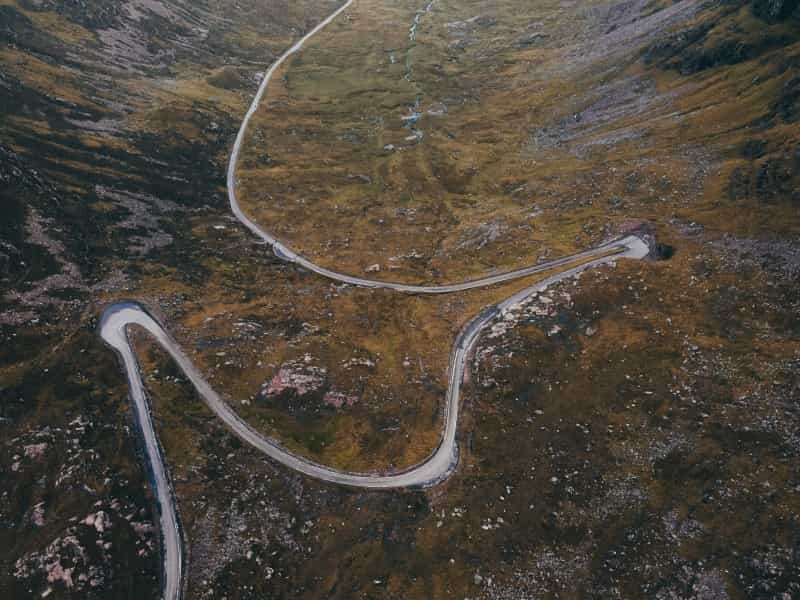
Day 1: Inverness to Applecross
Driving time: 2 hours
Miles: 82
To kick off your North Coast 500 itinerary, drive from Inverness Castle to the Applecross Peninsula.
First stop of the day could be at Rogie Falls – best seen after a rainfall, although also impressive in August and September when wild salmon leap upstream.
Driving onwards, admire the whitewashed Wester Ross village of Lochcarron before continuing on your journey via the epic Bealach na Bà. This single-track mountain pass is known for its switchback bends that descend 2,054 ft in around four miles towards lovely lochside Applecross. (Please be aware that this section of the route is not suitable for motorhomes or caravans. Instead, they should take the longer – but equally pretty – route from Shieldaig on the A896.)
From your Applecross campsite, you can visit the Heritage Centre to learn about local life, watch colourful sunsets and admire views across to the Isle of Raasay, and beyond it, Skye.
Search campsites around Applecross
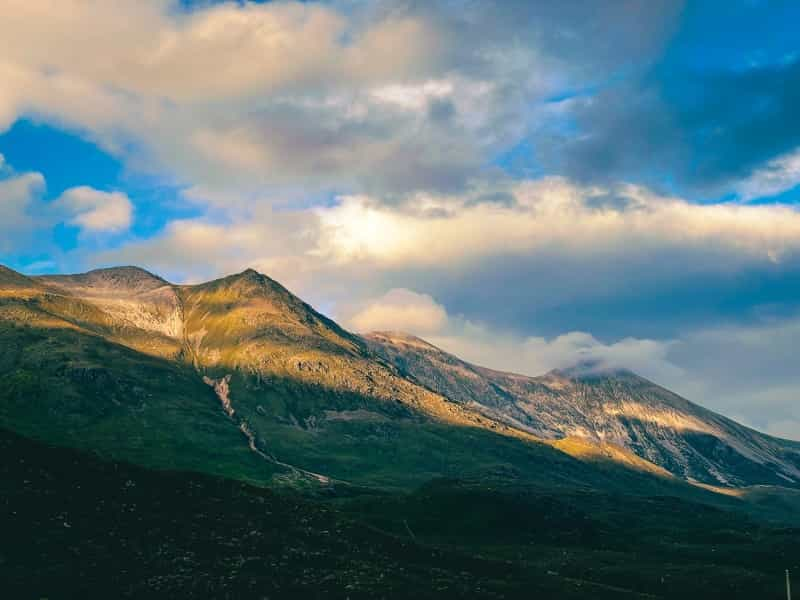
Day 2: Applecross to Gairloch
Driving time: 2 hours
Miles: 59
Make your way north along the coastline via waterside Shieldaig, where you can pick up cheese and smoked salmon from Loch Torridon Smokehouse. After Shieldaig, look out for tantalising views across sea lochs before you begin the drive through magnificent mountain scenery in Glen Torridon, where red deer graze close to the road. You’ll pass the distinctive shapes of Liathach and Beinn Eighe and, as there are plenty of walking routes around, you might like to hike one of the lower-level paths or attempt bagging a Munro (a hill over 3,000 feet).
Your journey carries on up the side of lovely Loch Maree, scattered with pine-clad islets, and finally ends at Gairloch harbour, where you can set up at a lochside campsite with gorgeous views of the Isle of Skye.
Search campsites around Gairloch
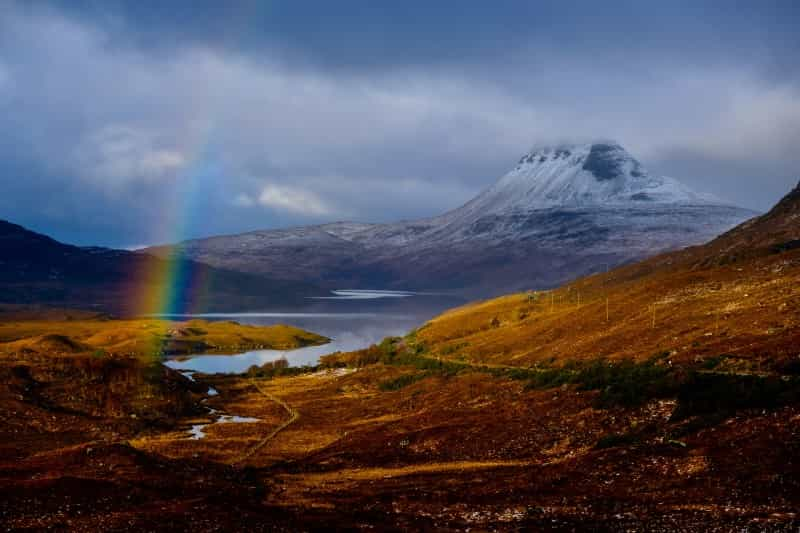
Day 3: Gairloch to Kylesku
Driving time: a little over 2 hours
Miles: 88
You'll skirt the edge of Loch Ewe first thing today, perhaps stopping off to see tropical palm trees (enabled to grow by the warm waters of the Gulf Stream) at Inverewe Garden and Estate. Spectacular views to the Isle of Skye accompany today’s route, which passes Gruinard Bay – a good place for a beach walk if the tide’s out – and then continues on towards Corrieshalloch Gorge National Nature Reserve for memorable waterfalls views from a Victorian-era suspension bridge over the mile-long River Droma gorge.
Pull up a pew at a seafront café in Ullapool next for a freshly landed seafood snack at lunchtime. Then keep on going through the wild countryside of Knockan Crag National Nature Reserve to Loch Assynt, dramatically framed by the peaks of Canisp, Quinag and Beinn Uidhe, to wander around the waterside remains of medieval Ardvreck Castle.
The remote fishing hamlet of Kylesku is your final destination for the day. Eat supper at the much-recommended Kylesku Hotel on the banks of Loch Glendhu, then retreat to a campsite among rugged scenery to sip malt whisky next to a blazing campfire.
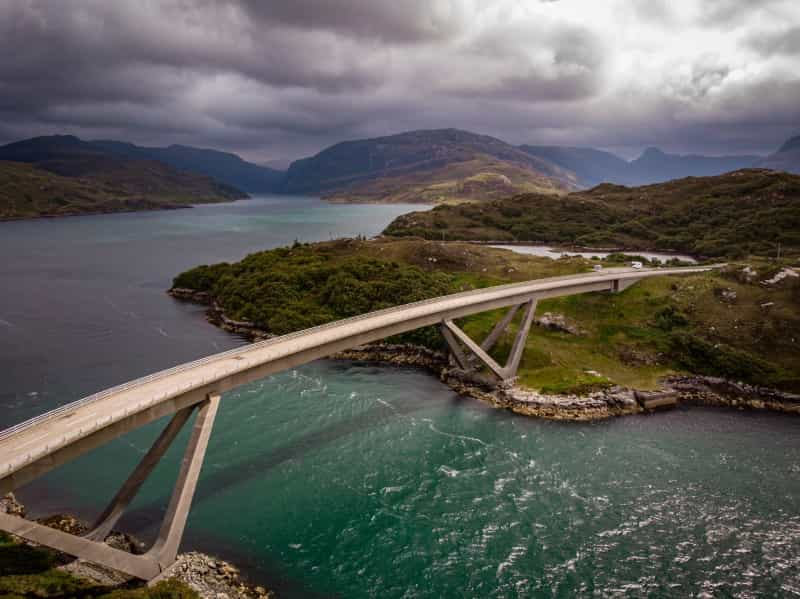
Day 4: Kylesku to Durness
Driving time: a little over an hour
Miles: 39
This is a short hop, so you may want to lengthen your trip by an hour or so with a detour to the spectacular inlet and white sand beach at Achmelvich (just be aware that you’ll need to take on some tricky roads to do this).
From Kylesku, head across Loch Gleann Dubh over the famed Kylesku Bridge – getting out of your vehicle briefly to soak up the lush loch views – towards Scourie Bay. Here you can take a small ferry (on demand from Monday to Saturday, April to September) across to Handa Island to see the seabird colonies in summer.
Back on dry land, as you approach Durness, veer off the route for 10 minutes to visit the white sands of Balnakeil Beach, or just take a moment to appreciate the North Sea’s turquoise shores from Sango Sands Viewpoint.
The enormous Smoo sea cave is an NC500 must-see just a mile east of Durness. Make this your last stop – it’s accessible via a circular stroll on a boardwalk, which leads inside the 50-ft-high cave mouth to a dramatic subterranean waterfall. Return to Durness for a night at your chosen campsite.
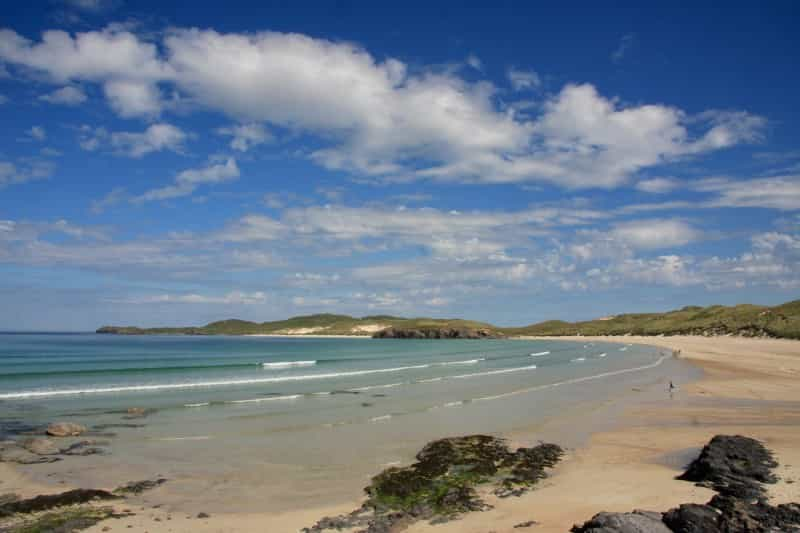
Day 5: Durness to John o' Groats
Driving time: just under 3 hours
Miles: 90
The brave of heart can start the day by heading for Ceannabeinne Beach, about 10 minutes’ drive east of Durness to zipline down to the sands from the clifftop, while families with younger kids carry on to the Kyle of Tongue for a short, easy stroll to Castle Varrich’s ruins.
Next, immerse yourself in the brutal history of the Highland Clearances of 1750 to 1860 at Bettyhill’s Strathnaver Museum. Grab a quick bite at the village’s Store Bistro and Bar, and then it’s back on the road to Strathy Point Lighthouse on the very tip of Cape Wrath, where you can often spot dolphins and whales (the best time is May to September).
Drive on to Thurso, stopping off to stock up at one of the supermarkets, then take in the dunes of Dunnet Bay before a jaunt to John O’Groats. Set up camp here to claim you've slept at the most northerly point of the UK’s mainland – and thanks to the area’s lack of light pollution, you might be lucky enough to catch the luminous Northern Lights when conditions are right in spring or autumn.
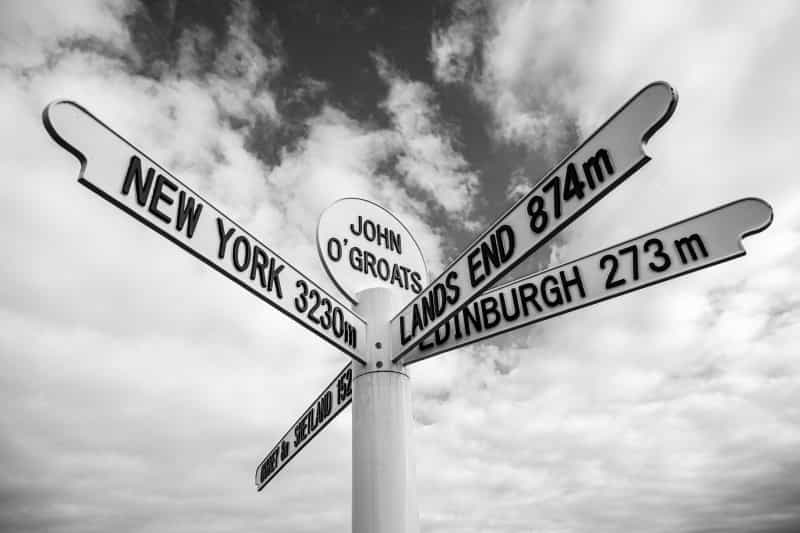
Day 6: John o' Groats to Dornoch
Driving time: an hour and 45 minutes
Miles: 76
After brewing up a strong pot of tea on the campfire, head to Duncansby Stacks to watch seabirds swoop around the bizarre coastal rock formations. From there, it’s a 40-minute drive south to your second stop of the day: the Whaligoe Steps. This steep set of 365 stone-cut steps was built in c.1792 so local fisherwoman could haul herring catches up from the natural harbour below.
Drive on to Dunrobin Castle to tour the fairytale French Baronial-style mansion and formal garden, or take the Big Burn Walk up to a waterfall at the head of a gorge. Then it’s a short hop to Golspie, the gateway to fly-fishing expeditions on local lochs and mountain-biking trails on Ben Bhraggie.
You’ll camp near the postcard-perfect town of Dornoch, with its castle and small cathedral, for the night. Look out for a beachfront site where you can watch the North Sea waves crash onto the sand from your pitch.
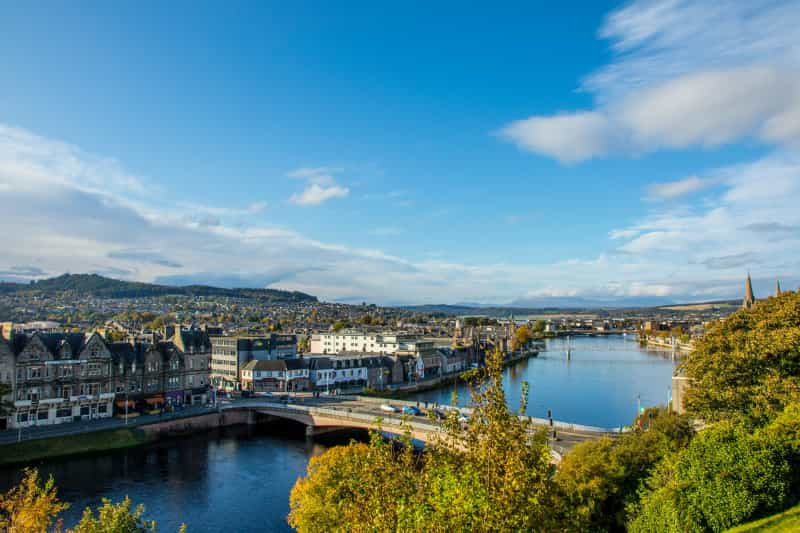
Day 7: Dornoch to Inverness
Driving time: an hour (without detours)
Miles: 44
It's a straight shot of an hour back down to Inverness from Dornoch, but there are potential detours along the way, including west (35 minutes' round trip) to the pretty Falls of Shin. You could also swing by Chanonry Point on the Black Isle, adding half an hour's driving time, to spot dolphins; you’ll need to schedule your visit for when the tide starts coming in as that’s when you’re most likely to see the dolphins coming inshore to feed. There are plenty of distilleries (such as Singleton or Whyte & McKay) to visit on this stretch too, for toasting to a successful trip with a tour and tasting. The Highland Malt Whisky Experience in Inverness is another good spot to celebrate your drive with a wee dram.
As it's your last night, consider wrapping up with a glamping stay at some form of luxury accommodation.
NC500 Campsites
Camping is the best way to stay along the NC500 because it gives you so much flexibility, but we recommend booking campsites in advance on Pitchup rather than turning up at a park and hoping there’s an available pitch. The route is especially busy in the peak summer season, so try to book a few months ahead if you can. In the quieter spring, autumn and winter months, you can occasionally get away with booking on the day of your stay, especially on the eastern coast where there are more campsites to choose from.
There’s also the option to try wild camping, as it is legal in most areas of Scotland. A mix of the two is perfect, allowing you to stop off at sites with showers and other essential amenities when available, then pitch up just about anywhere you like (within reason – see our wild camping guide for more info) the rest of the time.
Areas with numerous glamping and camping sites on the North Coast 500 include Lochinver, Thurso, Dornoch and Inverness. To browse all the top spots to stay along the NC500, take a look at the Highlands and Islands page on Pitchup, or check out some of our favourites en route, starting on the west coast and driving clockwise back round to Inverness:
Melvich – Kirkton Holidays
Park up on a touring pitch at this family-run site five minutes from Melvich beach. It’s a wonderful place for finding out about farm life in rural Scotland. Take a buggy tour of the land and meet the resident Highland cows and pygmy goats. In season, you can buy home-bred beef or lamb to grill up on your barbecue for a sustainable meal.
Dornoch – Grannie’s Heilan’ Hame Holiday Park
If you’re on an NC500 road trip with the children, sleep at this holiday park near the historic town of Dornoch. It sits by the powder-white sands of Embo beach and has family-friendly facilities including kids' and teens' clubs, bowling and an adventure playground with a zipwire. There’s also crazy golf and amusements to keep little ones entertained. Mum and dad might prefer the indoor pool, Jacuzzi and sauna, but everyone appreciates the views across the sparkling Dornoch Firth. From your tent, motorhome or campervan pitch, keep an eye out for bottlenose dolphins and seals skimming the surface of the water.
Inverness – Daviot Luxury Pods
During the first or last night of your NC500 itinerary, stop over at this glamping site with Highland views just 15 minutes’ drive south of Inverness city centre. Each well-insulated pod will keep you cosy whatever the weather is doing, and has a double bed, ensuite shower, kitchenette, TV and fold-down sofa to take care of all the family. There’s decking outside, with a firepit, plus a barbecue hut, with wooden seating so everyone can enjoy the Highland scenery in comfort.
Want more inspiration for your adventures in the Highlands and beyond? See our Scotland camping guide.
Five best NC500 beaches
There are so many spectacular beaches that warrant a stop-off as you follow the NC500 route around northern Scotland. Here are some that are favourites with the well-travelled Pitchup team, listed clockwise to match the route of our seven-day itinerary above.
Redpoint Beach, Gairloch
A secluded beach of startlingly red sand backed by dunes. There are rock pools here to keep the kids happy, spectacular views across to the Western Isles and plenty of seabird life too. Keep your eyes peeled for porpoises as you swim in pristine waters, or walk across to the tiny islet of Eilean Tioram when the tide is out.
Search campsites around Gairloch
Achmelvich Beach, Lochinver
Tucked into a rocky Assynt bay, Achmelvich Beach is in the North West Highland Geopark, although its snowy-white sands (actually crushed sea shells) and turquoise waters are more like something you might see in the Caribbean. It’s popular for windsurfing and kayaking, and may get crowded in summer, when you might like to escape to quieter Clachtoll Beach, 20 minutes’ drive away.
Search campsites near Lochinver
Balnakeil Beach, Durness
Sitting in a wide bay and overlooked by the remains of a 17th-century church and graveyard, the soft white sands of Balnakeil are sheltered by dunes covered in marram grass. This is the spot for long walks amid spectacular views to Faraid Head peninsula; take a packed lunch or call in at boho Balnakeil Craft Village for hot snacks.
Search campsites near Balnakeil
Torrisdale Bay, Bettyhill
Made up of soft sand, the beach is backed by rare machair scrub, which covers a scattering of ancient sites including stone circles and an Iron Age broch. At the western end is the wreck of a US military vessel blown up during World War II. You’ll often have this beach to yourself, increasing the chances of spotting seals and otters.
Search campsites near Bettyhill
Dunnet Bay, Thurso
A crescent of pristine white sand stretching for two miles and backed by dunes, this sheltered beach is known for swimming and sunbathing – until the wind gets up and then the surfers appear. Birdlife is abundant too; look out for oystercatchers and razorbills, plus the occasional puffin from the colony at Dunnet Head.
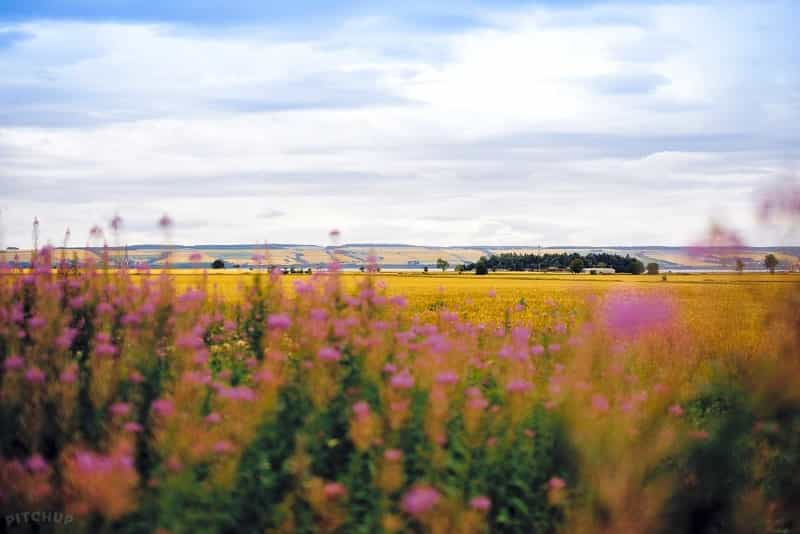
Pitchup campsites in the Highlands and Islands
Pitchup glamping in the Highlands and Islands
Can you camp anywhere on the NC500?
The Land Reform Act 2003 – Scotland's access legislation – lets you wild camp on most open land in the country. Just make sure to respect the Scottish Outdoor Access Code by:
-
Staying away from enclosed fields full of crops or farm animals
-
Leaving no trace by taking all possessions and litter away with you
-
Being considerate by not pitching up near buildings and houses
There are also plenty of official campsites on the NC500.
Can you do the NC500 and camp all year round?
Yes, the North Coast 500 is an all-season road trip. While there are more options available in high season, you can still find campsites open year-round on the NC500.
Some NC500 winter campsites operate shorter opening hours, and sometimes their usual facilities will not be available. In short, it’s best to book in advance if you’re considering completing the route in winter, rather than just turning up at a campsite unannounced. It’s also important to note that other businesses, like shops, pubs and restaurants, may also close over winter. Heavy snowfalls can be a hindrance too, especially over the steep, twisting Bealach na Bà pass.
Glamping can be a fantastic choice in the cooler seasons, as you get to stay cosy in insulated accommodation, from spacious bell tents to log cabins, with things like electric heating, extra blankets and/or wood-fired stoves.
So, hopefully we’ve convinced you that the North Coast 500 is the experience of a lifetime – and that camping on your Scottish road trip is the best way to travel. With all the info here, you should have a solid itinerary and all the facts you need to start planning your very own adventure.
NC500 FAQs
How long does the NC500 take?
You can do the North Coast 500 route in as little as five days, but if you have more time to spare we’d recommend taking it more slowly. Seven to 10 days is ideal, but there’s also plenty to see on the NC500 if you have a couple of weeks to spare. A longer holiday means you can tack on side trips to hotspots like Handa Island Wildlife Reserve, a 10-minute ferry trip from Tarbet on the west coast.
Can you do the North Coast 500 by motorhome or campervan?
The NC500 route is suitable for campervans and motorhomes, but the Bealach na Bà stretch – just north of Ardarroch to Applecross on the west coast – is not passable in a larger vehicle because of the sharp bends and steep gradients. It’s best to travel on the A896 instead. The B869 from Lochinver to Kylesku is also less accessible for motorhomes, so follow the A837 back from Lochinver on the main road to Skiag Bridge instead.
Should I drive the NC500 clockwise or anti-clockwise?
Go west from Inverness towards Applecross if you want to hit the Highland scenery straight away, but do remember that the east coast has its own charm, with historic fishing villages and castles to visit, as well as distilleries. And if you journey anti-clockwise along the Black Isle first, you’ll have gained confidence driving on single-track roads before you have to attempt Bealach na Bà, the twistiest, trickiest road along the entire NC500.
Can you camp along the NC500 if you have an access need or disability?
Yes! Use the accessibility search filters to filter campsites by yours or your travel companion's access needs.
If you'd like more tips on camping with a disability or access need, find more information in Pitchup's Accessibility Hub.